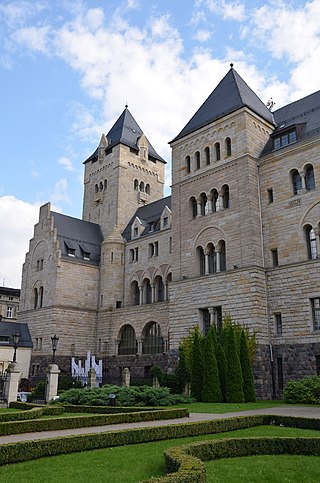
The Imperial Castle in Poznań, popularly called Zamek, "the Castle", is a palace in Poznań, Poland. It was built under German rule in 1910 by Franz Schwechten for Wilhelm II, German Emperor, with substantial suggestions from the Emperor.
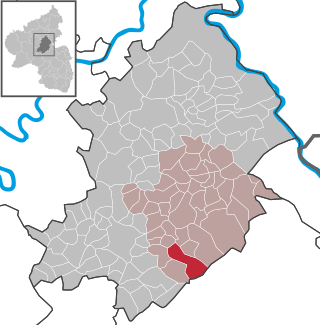
Sargenroth is an Ortsgemeinde – a municipality belonging to a Verbandsgemeinde, a kind of collective municipality – in the Rhein-Hunsrück-Kreis (district) in Rhineland-Palatinate, Germany. It belongs to the Verbandsgemeinde Simmern-Rheinböllen, whose seat is in Simmern.
The Wiesbaden Bismarck Tower was one of approximately 240 monuments built in honour of Otto von Bismarck between 1869 and 1934. Wiesbaden's Bismarck Tower was the tallest Bismarck memorial with a height of 50 metres (160 ft). The wooden tower was built in 1910 close to the former watch tower on the Height of Bierstadt. It was planned only as interim solution to be later replaced by a solid structure with a lift. However, this project did not materialise due to lack of funding. In 1916 the tower, nicknamed the "Eiffel Tower of Wiesbaden", was closed to visitors and used as military observation post. In 1918 it was demolished due to its poor state of repair.

Three Emperors' Corner is a former tripoint at the confluence of the Black and White Przemsza rivers, near the towns of Mysłowice, Sosnowiec and Jaworzno in the present-day Silesian Voivodeship of Poland. During the Partitions of Poland, from 1871 to 1918, it marked the place at which the borders of three empires that had divided Poland – the Russian Empire, Austria-Hungary and the German Empire – met.

The Jakobsberg is a hill, 235.2 m above sea level (NN), that forms the westernmost peak of the Wesergebirge chain and is the eastern guardian of the Weser gorge, the Porta Westfalica or "Westphalian Gate", in North Rhine-Westphalia (Germany).
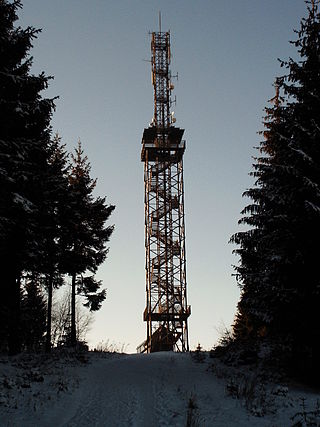
The Carlshaushöhe is a mountain, 626.3 m, in the Harz in the German state of Saxony-Anhalt.
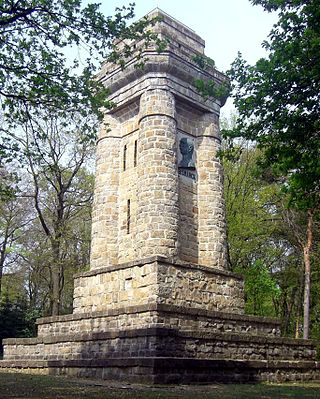
The Bismarck Tower located in Viersen was erected in honour of the chancellor Otto von Bismarck and has since become an icon of the city of Viersen.

Háj is the highest mountain in the Czech part of the Fichtel Mountains. It lies near Aš in the Czech Republic. On the summit there is a mountain inn that was destroyed by fire and an observation tower.
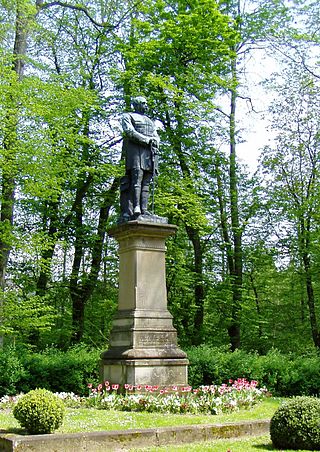
From 1868 onwards, Bismarck monuments were erected in many parts of the German Empire in honour of the long-serving Prussian minister-president and first German Reichskanzler, Prince Otto von Bismarck. Today some of these monuments are on the soil of other countries including France, Poland and Russia as well as the former German colonies on other continents.
Emperor towers or Kaiser towers are monuments that were built up to 1918 in honour of the German emperors William I, Frederick III and Wilhelm II in the German Empire or for Emperor Franz Josef in Austria-Hungary.

The Bismarck Tower on the 268-metre (879 ft) high Stahlsberg above Opperode in Germany is a monument to the former German chancellor, Bismarck. The tower can be used as an observation tower. It was built in 1914/15.
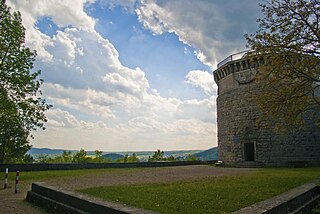
The construction of the Bismarck Tower located on the "Sinnberg", a hill in the German spa town of Bad Kissingen, started in 1914 following the plans designed by architect, Wilhelm Kreis. It was projected by the local Bismarck Tower Association under the chairmanship of its founder, pharmacist Oscar Ihl. This association was in favour of Bismarck and the German Empire and competed in a certain way with the Wittelsbacher Association, which, even after the Unification of Germany, regarded the Kingdom of Bavaria to be a sovereign kingdom and built the Wittelsbacher Tower in Bad Kissingen in 1907.
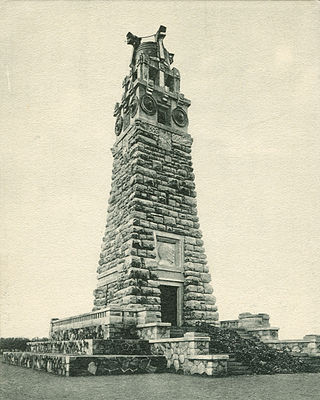
The Bismarck Tower in Hanover, Germany was a tower erected as a monument to the first Chancellor of the united German nation Otto von Bismarck for patriotic and nationalistic purposes, which then became a hub for national socialist events in the city until its dismantlement in 1935 as part of the building of the Maschsee.

The world's first Bismarck tower was erected by private initiative in 1869 in the village of Ober-Johnsdorf, Silesia, then part of Prussia. It stands on top of the hill now called Jańska Góra, 253 m above sea level. The tower itself is 23 m in height.

The Aachen Bismarck Tower is one of 173 still-standing towers and columns, which were constructed in the German Empire to commemorate the founder of the German state, Otto von Bismarck (1815-1898).

The sole surviving Bismarck tower in France is in the commune of Le Ban-Saint-Martin near Metz. The tower was erected in 1902 when the area was part of Alsace-Lorraine, a Reichsland of the German Empire. Though accessible to modern-day visitors, the Bismarck Tower of Metz is in a semi-ruined state, damaged by vandals and weathering.

The Bismarck Tower in Zielona Góra, Poland is one of the best-preserved Bismarck towers outside of present-day Germany. It is also called the Wilkanowska Tower, after the hill on which it stands.

The Bismarck Tower on the 497-metre-high Peterskopf in the Haardt mountains on the eastern edge of the Palatine Forest stands within an exclave of the municipality of Kallstadt in the German state of Rhineland-Palatinate.

The Bismarckturm is a 28 metre high Bismarck monument. It is located on the Schlossberg north of Burg (Spreewald).

The Bismarck tower in Freiburg im Breisgau belongs to a series of towers that were built in honor of Otto von Bismarck, the first German chancellor. It is located on the Schlossberg. It is 12.6 m (41 ft) tall and has a square base. The top of the tower can only be reached by climbing a ladder. Because of this it can not be used as an observation deck.





















